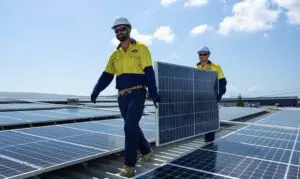Amid all the drama of the storm-induced blackouts that hit more than half a million customers in Victoria on Tuesday it was hardly noticed that the state – and the country’s main grid as a whole – set a raft of new output records.
According to data provided by GPE Nemlog, wind and solar set a new output record of 21.255 gigawatts at 12pm (grid time, or AEST) on Tuesday. In Victoria, at 11.35am, wind and solar hit a new output record of 5.6 GW.
This was little more than an hour before storms tore down at least six transmission towers west of Melbourne, setting off a cascading series of events that included the tripping of the giant Loy Yang A coal generator and more than 1 GW of load.
The biggest loss of power, however, was caused by the destruction of local networks, as storm cells tore down trees and powerlines and cut off power to more than half a million people. On Thursday morning, more than 80,000 home and business customers had still not been re-connected to the grid.
Victoria also set an output record for renewables (including hydro), of 6.3 GW at 12.25pm on Tuesday, just over half an hour before the transmission collapse. That record was a big leap from the previous peak of 5.9 GW reached on January 16 this year.
The overall grid, meanwhile, also hit record output of all renewables, including hydro, at the same time, setting a new peak of 22.17 GW, nearly 500 MW above the previous peak set in early December.

Victoria’s wind output fell suddenly as a reported grass fire took out the Stockyard Hill wind farm and the transmission losses had an impact on the Dundonnell wind farm (picture above).
But later in the after, at 3.40pm, the share of brown coal generation in Victoria also fell to a record low of just 17 per cent after the tripping of the giant Loy Yang A coal generator. The previous lowest share of coal in the state had been 29.8 per cent in late December, according to GPE NemLog.
Victoria was not the only state to experience record output for renewable technologies around that time. In South Australia, rooftop solar reached a new peak of 1.63 GW at 2pm, up from the previous 1.61 GW.
State demand at the time was relatively high, at more than 2.4 GW, so rooftop solar accounted for around 65 per cent of demand. It has, on occasions, produced the equivalent of all local demand in the state, with surplus large scale solar or wind being exported to Victoria.







